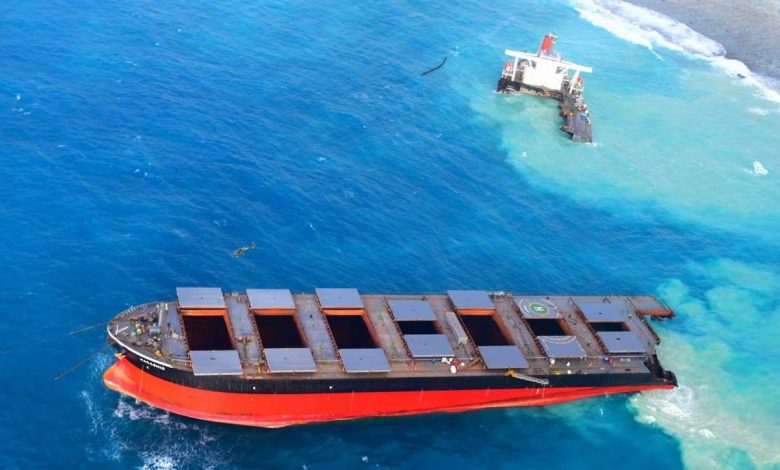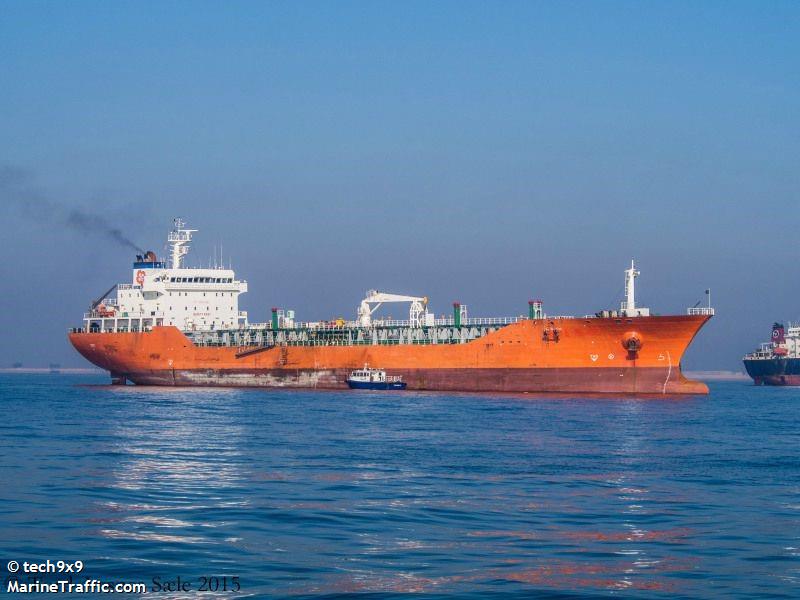Wakashio bow under tow as UNESCO protected sites come under severe threat

The bow section of the Wakashio bulk carrier is being towed eight nautical miles to an area with 2 km depth with its hatches open, while the stern of the Japanese vessel remains on a reef off Mauritius, with salvors waiting for the bad weather to pass.
The Panamanian-flagged ship grounded on July 25 and split in two on Saturday. It has quickly become the worst ecological crisis the Indian Ocean island republic has faced.
The latest satellite analysis of the bunker spill from the huge 203,000 dwt ship shows the 8 sq km oil slick has washed up in the UNESCO protected Blue Bay Marine Park, as well as the UNESCO protected Pointe d’Esny Mangrove Forests and the Ile aux Aigrettes nature preserve for endangered species.
The site of the spill in Blue Bay Marine Park is now directly over the site of the 1,000 year old brain coral that was the largest and oldest in the Indian Ocean.
The Wakashio, owned by Nagashiki Shipping, is insured by Japan P&I. Insurance experts are now expecting the bill for the clean-up operation from this disaster to top $500m.
Sebastien Lecornu, minister for France’s overseas territories who visited Mauritius over the weekend, said yesterday he believed the clean up operation would involve “at least 10 months of work”.
Christian Bueger, professor of international relations at the University of Copenhagen and and an honorary professor at the University of Seychelles, told Splash today that an independent inquiry was needed to look into how the accident happened and how authorities have handled it.
“The 1,000 tons of oil and diesel that leaked close to one of the greatest marine treasures of Mauritius have destroyed the habitat. Recovery will take decades. The disaster will occupy Mauritius for years to come,” Bueger, a director at maritime security network SafeSeas, said.
Investigators are reinterviewing the 58-year-old captain of the Wakashio today.

 bulk carrier is being towed eight nautical miles to an area with 2 km depth with its hatches open, while the stern of the Japanese vessel remains on a reef off Mauritius, with salvors waiting for the bad weather to pass.
bulk carrier is being towed eight nautical miles to an area with 2 km depth with its hatches open, while the stern of the Japanese vessel remains on a reef off Mauritius, with salvors waiting for the bad weather to pass.
All the ship’s holds open, so the intentions of the japanese are very clear. The question is whether the Mauritius government authorizes the scuttling and most important “where”, the position?
Latest update is that the bow will be towed to Alang India.
Unfortunately versions are changing day after day and at this point in time, no one has a correct vision of the future of this wreck.
I guess the tow has the papers to proceed to India, but is winter in S hemisphere and it will never arrive there with the holds all open. This type of fraud is frequent in salvage operations when the ship is scrap and there is not valuable cargo on board.
31.22.5 SOUTH / 30.34.5 EAST 11 NOVEMBER MT TEKTON, broken in half,50% scutled 50 % sunk. I survived ?
1975
Not sure why you would call it fraud. Although l condemn the practice it is not uncommon for vessels to be scuttled if their residual value does not support the cost of towage to a breakers. The “Stellar Banner” was scuttled very recently with 150,000 tons of iron ore on board. Even that was insufficient incentive to save her. While ships are relatively cheap, and scrap prices low, this practice is destined to continue.
We’ve been told it will be scuttled 8nm offshore, though neighbouring Reunion and environmental groups aren’t happy. The reef’s last two visitors, Angel 1 and Benita, also supposedly destined for a recycling yard, quickly ended up on the seabed instead.
There are now more than 100 assorted experts in the country, but differences are emerging about the best approach to take. Expect more mixed messages and confusion!
The Master and 1st Officer were arrested today (18 Aug) and charged with Endangering Safe Navigation under the Piracy and Maritime Violence Act. They are currently guests of the Mauritius Police Force and will return to court on the 25th.
Although another tug is said to be on its way to try to pull the stern section off the reef, any such action could cause even more damage. Interestingly, at PMQs today a minister said they planned to remove the remaining 30t of HFO “before the ship is dismantled”.
Anyone who believes that this mess can be completely cleared up should go to Prince William Sound and survey the remnants of the damage done by the “Exxon Valdez”. I am beginning to believe that Masters who are so grossly negligent as to inflict this kind of environmental damage should face jail time. What other deterrent can there be to this kind of reckless disregard for the environment? I never thought l’d find myself advocating such measures. How else are we to put that little ‘frightener’ bug in a Master’s mind such that he is more cautious and will react more defensively? Make the sanctions too harsh and Chief Officers may become hesitant to move up to Master. But there again only those officers who are prepared to accept such a challenge on those terms should be encouraged to step forward. It’s a grim business.
You are totally wrong:
The responsibility for the pollution caused in Mauritius rests solely and exclusively with the Japanese shipowners. And any attempt to blame crew for pollution would be unfair from any point of view. Let us remember that the captain reported the non-existence of contamination on the day of the grounding and that this point was thus confirmed by the island authorities. Let us also remember that the contamination started TWO WEEKS LATER, after the shipowners and insurers refused to assume their responsibilities with the ship and with bunkers.
And I, in turn, must respectfully disagree with you. First, the person in charge of any form of transport – whether ship, plane or bicycle – has to take responsibility for their actions. IF – and we must be careful not to pre-judge this case – there has been negligence, then the Master will have to accept the consequences. Had the ship not grounded on the reef, there would have been no risk of pollution. Even if you disregard the spill, the ship has caused substantial environmental damage, not least to the reef itself.
That said, the ship operator bears some responsibility for either allowing or failing to notice the fact the ship was off course. Had it not grounded it would have passed through an area forbidden to shipping (the Blue Bay Marine Park – clearly marked even on tourist maps never mind nautical charts) and then would have hit solid rock near Camp Carol. The police have been told the captain was in the habit of sailing near coasts on other routes to pick up wi-fi – did MOL know about this? Shades of Capt Schettino being allowed to get away with his coast-scraping exploits on Costa Concordia, perhaps.
And of course the Mauritian authorities must take a great share of the blame for the disastrous consequences of the spill. I fear this may amount to contributory negligence and reduce any compensation payout. It’s hard to know where to start. Two AIS units out of action, three radar stations out of action, failure to obey Mauritius’ own Merchant Shipping Act by not boarding the grounded vessel promptly, failure to call on the MPA’s tugs to hold the ship in its original position until salvage tugs arrived, failure to use tons of oil-spill equipment stored at the port, confused communications, poor training and, overall, a complete lack of professionalism.
This is not excusable or inevitable. Mauritius may be small, but it’s one of the richest countries in Africa, with free education for all, universities, a modern port, excellent communications, plentiful assistance from friendly countries. They had everything in place to be able to handle a disaster, but failed to use it. Why? That, even more than the cause of the grounding, is the big question that needs to be answered.
Arirang News has just reported that the “Indian” Master, and Chief Officer have been arrested. The video clip showed a man whose appearance does not suggest that he is Filipino. In my day the Japanese were amongst the biggest Japanese national crew employers, operating under the Japanese flag, with Japanese officers and ratings. In common with other developed world fleets, flagging and crewing out began in the 70s. For a while Japanese Masters manned cheaper-crewed and flagged ships. Finally, the last link was broken when Japanese-owned ships now have no Japanese representation on board their f.o.c.ships.